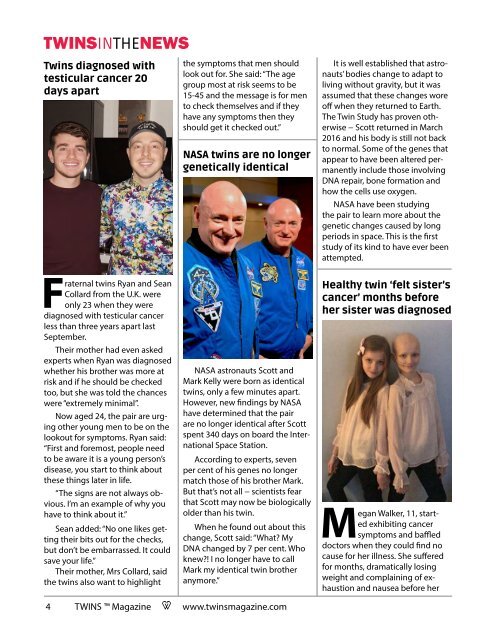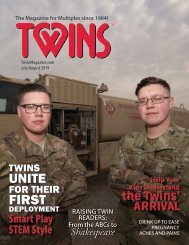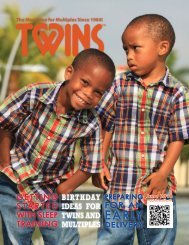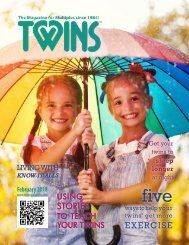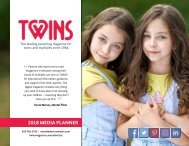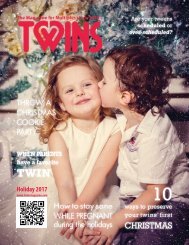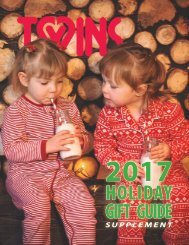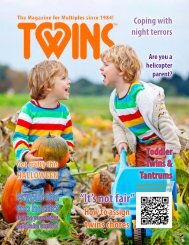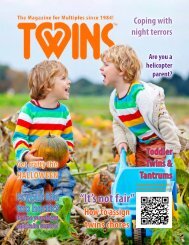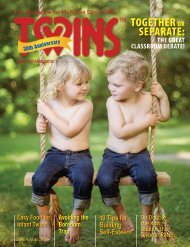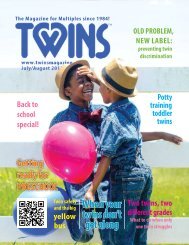APRIL 2018
April 2018 issue of TWINS Magazine, featuring: communicating with your twins, listening to twinspeak, avoiding stay-at-home burnout, cloth diapers and more!
April 2018 issue of TWINS Magazine, featuring: communicating with your twins, listening to twinspeak, avoiding stay-at-home burnout, cloth diapers and more!
You also want an ePaper? Increase the reach of your titles
YUMPU automatically turns print PDFs into web optimized ePapers that Google loves.
TWINSINTHENEWS<br />
Twins diagnosed with<br />
testicular cancer 20<br />
days apart<br />
the symptoms that men should<br />
look out for. She said: “The age<br />
group most at risk seems to be<br />
15-45 and the message is for men<br />
to check themselves and if they<br />
have any symptoms then they<br />
should get it checked out.”<br />
NASA twins are no longer<br />
genetically identical<br />
It is well established that astronauts’<br />
bodies change to adapt to<br />
living without gravity, but it was<br />
assumed that these changes wore<br />
off when they returned to Earth.<br />
The Twin Study has proven otherwise<br />
− Scott returned in March<br />
2016 and his body is still not back<br />
to normal. Some of the genes that<br />
appear to have been altered permanently<br />
include those involving<br />
DNA repair, bone formation and<br />
how the cells use oxygen.<br />
NASA have been studying<br />
the pair to learn more about the<br />
genetic changes caused by long<br />
periods in space. This is the first<br />
study of its kind to have ever been<br />
attempted.<br />
Fraternal twins Ryan and Sean<br />
Collard from the U.K. were<br />
only 23 when they were<br />
diagnosed with testicular cancer<br />
less than three years apart last<br />
September.<br />
Their mother had even asked<br />
experts when Ryan was diagnosed<br />
whether his brother was more at<br />
risk and if he should be checked<br />
too, but she was told the chances<br />
were “extremely minimal”.<br />
Now aged 24, the pair are urging<br />
other young men to be on the<br />
lookout for symptoms. Ryan said:<br />
“First and foremost, people need<br />
to be aware it is a young person’s<br />
disease, you start to think about<br />
these things later in life.<br />
“The signs are not always obvious.<br />
I’m an example of why you<br />
have to think about it.”<br />
Sean added: “No one likes getting<br />
their bits out for the checks,<br />
but don’t be embarrassed. It could<br />
save your life.”<br />
Their mother, Mrs Collard, said<br />
the twins also want to highlight<br />
NASA astronauts Scott and<br />
Mark Kelly were born as identical<br />
twins, only a few minutes apart.<br />
However, new findings by NASA<br />
have determined that the pair<br />
are no longer identical after Scott<br />
spent 340 days on board the International<br />
Space Station.<br />
According to experts, seven<br />
per cent of his genes no longer<br />
match those of his brother Mark.<br />
But that’s not all − scientists fear<br />
that Scott may now be biologically<br />
older than his twin.<br />
When he found out about this<br />
change, Scott said: “What? My<br />
DNA changed by 7 per cent. Who<br />
knew?! I no longer have to call<br />
Mark my identical twin brother<br />
anymore.”<br />
Healthy twin ‘felt sister’s<br />
cancer’ months before<br />
her sister was diagnosed<br />
Megan Walker, 11, started<br />
exhibiting cancer<br />
symptoms and baffled<br />
doctors when they could find no<br />
cause for her illness. She suffered<br />
for months, dramatically losing<br />
weight and complaining of exhaustion<br />
and nausea before her<br />
4 TWINS Magazine A www.twinsmagazine.com


